I've really been looking forward to this post. I've been snapping pictures of post-disaster Japan for the past month in hopes of sharing what it's like here right now. Like I said earlier, life is back to normal in Tokyo but that doesn't mean that anyone has forgotten about the earthquake/tsunami/Fukushima Nuclear Plant situation. The country is in a recession, people are still missing and without homes and the summer heat is coming, which will put a strain on power in the greater Tokyo area.
By far, my favorite sign posted around my neighborhood, Akasaka. The big type above the adorable pig cartoon roughly translates to "Turn on your energy!" however "energy" here is not electrical energy (that's sort of the opposite of what they're trying to tell us) bur rather, your courage/energy/vigor. I see this sign all the time, but it wasn't until yesterday that I realized that at the bottom it says:
"We are open with minimal light and maximum smile"
Though normalcy has been restored in Tokyo, there are some signs of change. Buildings and metro stations are noticeably darker and many escalators are roped off to save power. Signs informing the public of cutbacks in power can be seen everywhere. It is a bit of a graphic designer's wet dream if you ask me.
Before the earthquake, Tokyo Metro unveiled big shiny TV screens at the entrances of their stations and also on the platforms. Poor timing for them but I like how they're using the monitors to show the daily power usage in Tokyo. This sign basically shows how much energy is being used compared to estimated capacity.
This is a sign from our local Pachinko parlor. Pachinko is BIG in Japan. I still don't understand it, but they're kind of like a hybrid between arcades and casinos. People sit in front of these pachinko slots for hours smoking and waiting to win. They're a big problem in Japan actually. There's always some sad story in the news about a baby that died because their parents got so into pachinko that they forgot to feed them. They're loud and smoky but also well air-conditioned. Many people say that if all the pachinko parlors in Japan were shut down this summer, we wouldn't need brown-outs. I'm not sure if that's true, but it's not a bad idea. Seems that the Pachinko owners are self-aware, as they are advertising a 25% cut back in power.
Apparel stores are helping consumers gear up (or down) for the extra summer heat with tips on how to dress properly for the warm weather. Workers are allowed to wear t-shirts and jeans this summer under the government backed "Super Cool Biz" energy-saving campaign. I'm curious to see if women are still willing to shield their porcelain skin under matte black tights this summer.
More trendy PSAs. The rainbow banner above again uses the kanji for "genki" meaning healthy/robust/vigor. It's basically saying "Be Healthy/Be Energetic for Japan" The "Power Off and Carry On" poster is another favorite of mine since all the morale boosting posters around town are reminiscent of the classic British WWII "Keep Calm and Carry On" advert. (See how I threw in some Brit slang there?)
Ganbarou Nippon! Ganbare Nippon! Let's Go Japan! Go Japan!
There is no shortage of "Ganbare" posters in Japan. The verb "ganbaru" is one that you learn early on when you move to Japan. It means "to fight/to do one's best" and Japanese people will say to you a lot when they realize that you don't speak Japanese. It is meant as encouragement and you hear it all the time. It's also used in sports, the Japanese equivalent to "Go Team!"
I had a hard time figuring out the sign on the right but from what gather, at the top, they're using some Northern Japan slang for "Ganbare" "Keppare Tohoku" is how it reads. I think that's a nice show of solidarity from a small town near Tokyo, Ome. It's kinda like when the Saints were in the Super Bowl after Katrina and everyone kept saying "Who dat dem Saints"
And this concludes the Japanese language lesson portion of this post.
Even the fashionistas and too cool for school kids in Harajuku are getting in on poster fun. I like their angle of promoting the Red Cross.
Though it has died down a bit, you'll still see collection boxes at convenience stores. The picture on the right is actually of 2 TV personalities collecting donations at Shinjuku Station. I don't know their names, but I recognized them. The one in the blue coat once had to bounce 10 times on a pogo stick on the edge of an active volcano in South America.
By the way, if you want to donate, my charities of choice is Second Harvest Japan and you can donate here.
I'm sure I'll come across more great signs in the future, but this seems to be a good stopping point.
Just kidding, I forgot that I wanted to share this JR commercial that makes me teary eyed every time I watch it. It was filmed prior to the earthquake and I don't think it ever aired but I think that it has a nice message in light of everything. This is the debut of the Kyushu Shinkansen route. Kyushu is the very southern part of mainland Japan and even though this has nothing to do with the North, it has a nice message. It really capture the playful and supportive Japanese spirit.



























































